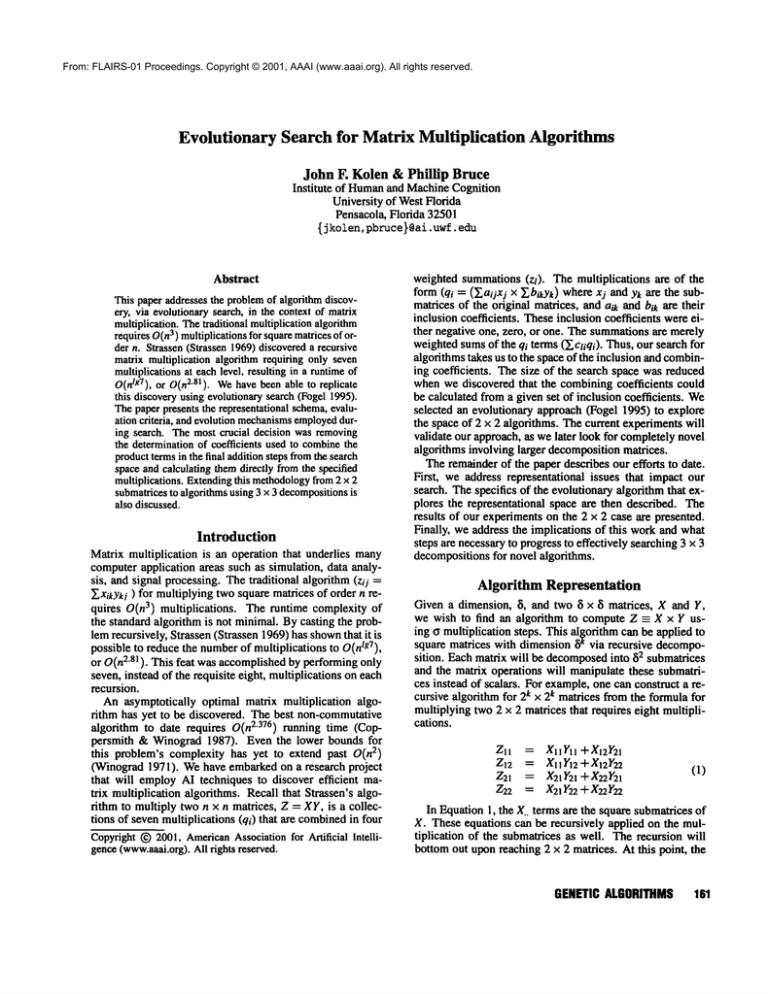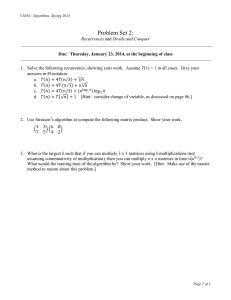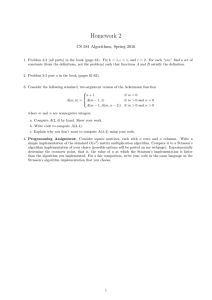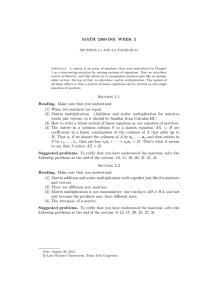
From: FLAIRS-01 Proceedings. Copyright © 2001, AAAI (www.aaai.org). All rights reserved.
Evolutionary
Search for Matrix Multiplication
Algorithms
John F. Kolen&Phillip Bruce
Institute
of Humanand Machine Cognition
University of West Florida
Pensacola, Florida 32501
{ j kolen,pbruce}@ai
.uwf.edu
Abstract
This paper addresses the problemof algorithm discovery, via evolutionary search, in the context of matrix
multiplication. Thetraditional multiplication algorithm
requires O(n3) multiplicationsfor squarematricesof order n. Strassen (Strassen 1969)discovereda re, cursive
matrix multiplication algorithm requiring only seven
multiplications at each level, resulting in a runtimeof
O(n/x7), or O(n2"81). Wehave been able to replicate
this discoveryusing evolutionary search (Fogel 1995).
Thepaper presents the representational schema,evaluation criteria, and evolution mechanisms
employedduring search. The most crucial decision was removing
the determination of coefficients used to combinethe
producttermsin the final addition steps fromthe search
space and calculating themdirectly from the specified
multiplications. Extendingthis methodology
from2 x 2
submatricesto algorithms using 3 × 3 decompositions
is
also discussed.
Introduction
Matrix multiplication is an operation that underlies many
computer application areas such as simulation, data analysis, and signal processing. The traditional algorithm (zij
Y.xikYki ) for multiplying two square matrices of order n requires O(n3) multiplications.
The runtime complexity of
the standard algorithm is not minimal. By casting the problem recursively, Strassen (Strassen 1969) has shownthat it
possible to reduce the numberof multiplications to O(nl[~7),
or O(n2"gl ). This feat was accomplished by performing only
seven, instead of the requisite eight, multiplications on each
recursion.
An asymptotically optimal matrix multiplication algorithm has yet to be discovered. The best non-commutative
algorithm to date requires O(n2"376) running time (Coppersmith & Winograd 1987). Even the lower bounds for
2)
this problem’s complexity has yet to extend past O(n
(Winograd 1971). Wehave embarked on a research project
that will employ AI techniques to discover efficient matrix multiplication algorithms. Recall that Strassen’s algorithm to multiply two n x n matrices, Z = XY, is a collections of seven multiplications (qi) that are combinedin four
Copyright(~) 2001, AmericanAssociation for Artificial Intelligence(www.aaai.org).All rights reserved.
weighted summations (zt). The multiplications are of the
form (qi = (~aijxj Y.bikYk) where xjandYk are the submatrices of the original matrices, and a/k and bik are their
inclusion coefficients. These inclusion coefficients were either negative one, zero, or one. The summations are merely
weightedsums of the qi terms (~’.cliqi). Thus, our search for
algorithms takes us to the space of the inclusion and combining coefficients. The size of the search space was reduced
when we discovered that the combining coefficients could
be calculated from a given set of inclusion coefficients. We
selected an evolutionary approach (Fogel 1995) to explore
the space of 2 x 2 algorithms. The current experiments will
validate our approach, as we later look for completely novel
algorithms involving larger decomposition matrices.
The remainder of the paper describes our efforts to date.
First, we address representational issues that impact our
search. The specifics of the evolutionary algorithm that explores the representational space are then described. The
results of our experiments on the 2 x 2 case are presented.
Finally, we address the implications of this work and what
steps are necessary to progress to effectively searching 3 x 3
decompositions for novel algorithms.
Algorithm Representation
Given a dimension, 5, and two 5 × 5 matrices, X and Y,
we wish to find an algorithm to compute Z -- X × Y using o multiplication steps. This algorithm can be applied to
square matrices with dimension 5~ via recursive decomposition. Each matrix will be decomposedinto 52 submatrices
and the matrix operations will manipulate these submatrices instead of scalars. For example, one can construct a recursive algorithm for 2k × 2k matrices from the formula for
multiplying two 2 × 2 matrices that requires eight multiplications.
Zll
Z12
Z21
Z22
=
=
=
=
Xl 1Y11"l- XI2Y21
XIIYI2-I-X12Y22
X2IY2I"Jf-X22Y21
X21Y22+X22Y22
(1)
In Equation1, the X. terms are the square submatrices of
X. These equations can be recursively applied on the multiplication of the submatrices as well. The recursion will
bottom out upon reaching 2 × 2 matrices. At this point, the
GENETIC ALGORITHMS
161
XllYII
[
XilYI2
Xll
O
l
Y21 X11 Y22 Xl2Yl
0
0
0
I ’’’
...
X21 El I ..-
--1
Figure l:ThevectorrepresentationforXiiYli-X21Yllis[
=
(XIl+X22)*(YII+Y22)
q2
q3
=
=
(X21+X22)*YII
XlI*(YI2-Y22)
q4
=
X22*(Y21-Yll)
q5
q6
q7
Zl2
Z21
= (XII+XI2)*Y22
= (X21-XII)*(YII+YI2)
----- (XI2-X22)*(Y21+Y22)
ql+q4--q5+q7
=
= q3 + q5
= q2 + q4
Z22
=
ZII
ql
a 8
(2)
8
X BrklYkllCrnm
k,l=l
(3)
The Ar and Br matrices identify which terms of X and Y
to include in the calculation of the left and right side of the
product operation. The Cr matrix controls the summationof
the products. In practice, the elements of these matrices are
taken from the same ring defining X and Y. Strassen’s algorithm, for example, has Ar and Br with elements taken from
the set {- 1,0, 1 }. Multiplications by scalars is asymptotically equivalent to adding two matrices and thus are ignored
in the multiplication count. Originally, we limited the elements of Ar, Br, and Cr to the set {- 1,0,1}.
Initial experiments within the search space over Ar, r,
B
and Cr, as defined above, yielded dismal results. Wefound
IF or simplicity ofanalysis, we assumethatdimensionofthe
matrices is a powerof two.
162
FLAIRS-2001
0 0
O 0
O
0 -l
0
O 0 0
]
0 0
0 0 ].
that maintaining the relationship between the inclusion and
combination coefficients was difficult, if not impossible.
This difficulty arises from the coupling of these parameters.
In the explanation that follows, we showthat it is possible to
eliminate the Cr matrices from the search space by directly
calculating it from the contents ofAr and Br. As we shall see
below, the same calculation turns out to yield an excellent
objective function. Consider then an alternate formulation
of Equation 3:
8
Note that in all cases, the multiplication operators take a
subset of values from X and multiply them with a subset
from Y. This constraint arises from the observation that no
Z submatrix formula contains quadratic terms solely from
one multiplicand or the other (i.e. no XIIX22 terms appear).
In addition, each term present in the product of sums (POS),
q., and sumof products (SOP), Z.., is multiplied by a coefficient of either - 1 or 1. The representation schemedescribed
below will preserve these two constraints.
Wecan define the search space that satisfies these constraints mathematically. Consider the 5 x 8 matrices r,
A
B’ and Cr for re{ 1,..., a} such that the following equation
holds for all n,m E { I,...,8}:
8
0
Yl2 XI IY21 X22 Y22
0
Znm-~-
+q3--q2+q6
Z XnpYp m = Z( X Arj xij)(
p’=l
r=l i,j=l
Xll
0
1 0
equations will be operating on scalars instead of submatrices. The runtime, T(n), for multiplying two n x n matrices is T(n) = ST(n~2)O(n2). An
alysis oftherecurrence
equation shows that this algorithm will run in O(n3) time)
In this paper, we shall be concerned with the special case
of 8 = 2 and o = 7. Strassen (Strassen 1969) addressed this
case and was able to rewrite these equations in a sum of
products form (Equation 2).
ql
XllYll
...
Z XnpYp
p=l
o
8
m = Z( Z DrjklXij
r=l i,j,k,l=l
Ykl)Crn
(4)
The newterm, Drjkt, the outer product ofAr and Br, identifies the contribution of a pair of terms drawn from X and
Y. This selection process can be abstracted by considering
the groupof elements{XijYkt}i,j,k,tei 1,..,8} with the addition
operation to be a vector space over the field of rational coefficients. Underthis interpretation Equation 4 states that for
any n and m a certain vector ~’m,, whoseelements axe either
zero or one, is equal to a linear combination of 0 vectors.
Figure illustrates the vector representation schemawith the
representation for the product term Xil 1"11 - X21I’11. Defining the matrix D to be the 84 x ff matrix whose columns
correspond to the vectors Ai~kl and defining F,,m to be the
if-dimensional
vector whose elements are Cmn, we may
then express Equation 5 as the following linear system:
~mn = AF~
(5)
Or expressed for all m,n E {1, .-,8}:
s = AC
(6)
where S is a matrix depending only on 5 and whose elements are each membersof the set {0,1 }. If we then specify values for A we may attempt to solve Equation 6 for C.
Figure illustrates the matrices constructed for the products
found in Strassen’s original algorithm (Equation 2). If a solution is found, then we have we have Arj and BIt satisfying
Equation 3 and a matrix multiplication algorithm with the
desired properties.
Weplaced additional restrictions on the representations
to contract the search space. For instance, it is clear that the
matrices Ar and Br must have at least one non-zero entry in
order to yield a solution to Equation 3. It is also true that
in Strassen’s algorithm, these matrices never have more than
two entries so we might benefit from placing an upper bound
on the number of non-zero elements. While we considered
utilizing this constraint early in our work, we found that it
was unnecessary to constrain the search space in this manner. Furthermore, multiplying either of these matrices by - l
has no effect in that this negation can be instantiated during
1
0
0
0
0
0
I
0
0
0
0
0
0
0
0
0
0
1
0
0
0
0
0
1
0
0
0
0
0
0
0
0
0
0
0
0
0
0
0
0
1
0
0
0
0
0
1
0
0
0
0
0
0
0
0
0
0
1
0
0
0
0
0
1
1
0
0
1
0
0
0
0
0
0
0
0
1
0
0
l
0
0
0
0
0
0
0
0
1
0
0
0
1
0
0
0
0
1
0
-1
0
0
0
0
0
0
0
0
0
0
0
0
0
0
0
0
0
0
0
0
0
0
0
0
-1
0
1
0
0 -1
0 -1
0 0
1 0
0 0
0 0
0 0
1 0
0
1
0
l
0 0
0 0
0 0
0 0
0 0
0 0
0
0
0
0
0
0
1
1
0
0
0
0
0
0
-1
-1
measureshowclose it is to a solution. A normis then estimatedfor the matrix AC-S. Moreprecisely, we define it to
be the function
f(A) = n~n IlmX- sII
C
Figure 2: The system of equations corresponding to
Strassen’s original algorithm(Equation2). The sixteen rows
correspondto the sixteen possible pairings of submatrices
from X and Y. The four columnsof the matrix on the right
handside of the equal sign correspondto the four submatrices of the resulting matrix. The sevencolumnsof the other
matrixcorrespondto the sevenproducts. C is a 7 x 4 matrix
of unknowncombinationcoefficients.
the calculationCr. Restrictingthe first non-zeroentry to one
further reduces the search space. Our experimentsbelowreflect the applicationof these last tworeductiontechniques.
Searchingfor Algorithms
Given the algorithmic space described above, we nowaddress the problemof search. Weselected an evolutionary
approachas our search tool (Fogel 1995). The justification
for this choiceis two-fold. First, wefelt that a populationbased approach wouldwork well for this task. Second, we
wantedto operate directly uponthe values defining our algorithms. This latter decision allows us to avoid problems
associated with bit encodingsused in genetic algorithms.
r
Anindividual is consists of the sets containingall the A
and Br matrices. The population contains a large number
of such individuals. A reproductive generation consists of
the followingsteps. First, pairs of individuals fromthe population are selected for reproductionaccordingto their fitness. The newbornindividuals undergo mutation and are
then rankedwith the older populationby the fitness function
and those with high fitness (see below)scores are removed
fromthe population. Generationsare repeated until either a
satisfactory algorithmis found, or the numberof generations
reaches a predefinedstopping value.
The fitness function must somehowestimate howclose
the individual is to actually computingthe matrix multiplication. Usingthe vector space modeldescribed in the previous section, wedefine an objective function basedon the
nearness of the matrix S of Equation6 to the range of the
transformationA. If the systemin Equation6 is solvable,
then the goal has beenreached. In the likely event that the
matrixis unsolvable,weturn to an objective function f that
(7)
wherethe normis taken to be the Euclidean norm. Note
that such a function is 0 if and only if A correspondsto a
solution to the problem.The lowerthe score its value, the
closer the individualis to beinga solution.
If we assumethat A is not the zero matrix, the degenerate
case, then because f is strictly convex, boundedbelow,and
not boundedabove, any critical point is a minimizer. Because the gradient of f is ATAX-ArS, we must therefore
solve the system:
ATAX = ATs
(8)
forXin order to find a minimum
off. Thusthe evaluation
of f (Equation 9) for any given X consists of a few basic
matrixcalculationsand is reasonablyfast.
f(a) = Ha(art)-Iars Sll
(9)
The objective function, f, described abovecaptures the
mainfeatures of our goal states. Wefound, however,that the
search mechanism
neededadditional informationin order to
discover solutions to this problem.The fitness function is
the objective function adjusted in twoways.First, if an individual’s matrixis sparse, then the score is increased. Individuals with zero rows in their A and B matrices will also
incur a similar penalty. Both of these augmentationshelp
the evolutionary mechanism
quickly escape the flat regions
of the objective function that are often foundwith randomly
generatedindividuals. Notethat fit individuals havelowfitness scores, zero indicating a workingalgorithm.
Whilethe fitness function describedaboveprovides score
for a given individual, we allowthe actual fitness score for
the individual changesover time. That is, each generation
an individual survives, its fitness is increasedby a constant
amount.This serves to keeppotentially goodstarting points
in the population, but eventually removesthem, as fitness
increases, to makeroomfor youngerindividuals.
Havingdefined a fitness function, we then define operations for the creation of newindividuals. Thesimplest operation is the creation of an individual whosechromosomes
have Ar and Br matrices with randomlychosen entries. We
call this operationimmigration.It serves to increasethe diversity of the populationand is usedto initialize the population.
The reproduction of two individuals, or cross-breeding,
consists of the creation of two new individuals whose
chromosomesare derived from the parent using uniform
crossover (Ackley 1987; Syswerda 1989). Consider the
chromosome
to be the serialization of Ar’s and Br’s. The
children are constructed by walking downthe two chromosomesof the parents and copy the current genome,an rA
or a if, from one parent to either child and then copying
the correspondinggenomefromthe other parent to the other
child. Probability of a child receiving a genomefrom the
GENETICALGORITHMS 163
first parent is 0.5. Thus, the children receive a complementary pairing of their parent’s genetic material while maintaining integrity of the the low-levelsums(the subsets from
selected from matrices A and B).
For any given individual P, mutationis the creation of a
newindividual O whosechromosomes
are identical to those
of P, except for the probabilistic changingof each element
in the Ar and Br matrices to one of the two other possible
values. Theprobability of any elementchangingis such that
the expected numberof changedelements is fairly small,
thoughit increases with the age of P in order to promote
diversity in the population. The restrictions on the structnre of Ar and Br, first non-zeroelementis positive and at
least one non-zero element, described aboveare maintained
during this process. The second type of mutation focuses
the attention of this mechanism
on problematicareas of the
chromosome.
Thus, our evolutionary algorithm for searching the space
matrix multiplication methodsconsists of the following
steps. First, a population of immigrantsis created. New
membersof the population are created using cross-over and
mutation. Cross-overparents are selected according to the
fitness score. Theless fit individuals are then removedfrom
the population.
Results
Our evolutionary search was performedunder the following
conditions. The base population size was three hundredindividuals. Cross-breedingyielded three hundrednew members from150pairings. Anadditional three hundredindividuais were created fromsimple mutationof existing individuals. Oneach generation, ten newimmigrantswere addedto
increase genetic diversity of the population. The base mutation probability, that is, the probability of a single gene
mutating was 0.07. This probability increased by 0.07 for
every generation an individual remainedin the population.
A penalty of 0.2 was incurred to the fitness score for each
generation during the life span of the individual. Themaximumnon-zero coefficients in the sumof POSwas four. The
numberof non-zerocoefficients in the POSwasnot limited.
Weemployeda restart method.After 550 iterations, the
search algorithm empties the population and starts with a
newset of randomlygeneratedindividuals. After 24 restarts,
a solution wasfound after 91 generations. It consisted of
sevenmultiplications and eighteen additions and is of the
samecomplexityas Strassen’s decomposition(Equation 2).
ql
= X2l*(r]2+r22)
q2
q3
6]4
=
=
=
(XII - XI2) * YII
(X12-X21)*(YII-Y22)
(X21- X22) * Y22
q7
ZI I
=
=
XI2*(YII+Y2])
q2 + q7
q5 = (x,2-x22).(r2~+r22)
q6 = (xl,-x21).(r.+r~2)
Zi2 =
Z21 =
Z22 =
164
FLAIRS-2001
--ql--q2--q3+q6
--q3 +q4 -- qs + q7
q l -- q4
(10)
Conclusion
The discovery of a recursive matrix multiplication algorithm was described above. Since the original discovery,
other schemeshavepresented themselves,all within similar
time frame and solution complexity. Our automatedsearch
methoddiffers fromthat used by Strassen. Computer
search,
however,is not novel in this area. Brent (Brent 1970) used
a least-squares minimizationtechnique on a function whose
minimacorrespondwith matrx-mulfiplication algorithms to
rediscover the 8 ---- 2 solution. Oursearch, however,differs fromthat of Brent in that the function to be minimized
is simpler, and the optimization is doneusing evolutionary
search.
Since Winograd(Winograd1971) demonstrated that for
the 2 x 2 case, sevenmultiplications are necessary, wewill
have to turn to larger decompositionsif weare to discover
better algorithms. Wecurrently are examiningthe 3 x 3 case
with twentythree multiplications. Wehavebeenable to discover solutions whenour initial populations contain mutations of the a target solution. Success has been achieved
with populations with 120 mutationsof a workingsolution,
however,randominitial populations haveyet to discover a
workingsolution. Themaindifficulty here is that the number of possible term one side or the other of a product has
increased from four to nine. Withoutrestricting the relationships betweencoefficients, the numberof possible elementsin a multiplicand (the subset of X or Y submatrices)
has increased from34 tO 39. Giventhat the search space for
the entire tableau contains 72kitems for the 2 x 2 case, the
m2k, where 7 < m < 33 = 27, algorithms in the new space
demandsattention, otherwise we are drawninto an exponential quagmire.Our current efforts, thus, are focusedon
restricting the search space. In addition, weare examining
additional population management
techniques, such as having the age of an individual mediatemutation.Currently, the
best 3 x 3 algorithm requires 23 multiplications (Laderman
1976).It is unknown
at this timewhetheror not 23 multiplications is necessaryfor this case. It is our hopethat wewill
be able to find a 3 x 3 algorithmrequiring fewermultiplications.
Even though we have only matched the complexity of
currently knownalgorithms, the results of the search described above can be used in other ways. Weare currently
exploring the idea that one can dynamicallyreduce the number of multiplications for recursive matrixmultiplication by
selecting an decompositionappropriate for the given matrices. Consider the case whenthe submaUicesof X are
equal. Thenq2 through q6 of Strassen’s algorithm need not
be calculatedas the left handside is the zero matrix. Yet, if
Xli ---- X21---- -X12= --X22,five of the sevenmultiplications
of the second algorithm disappear. The count of elements
equal, and negated, betweensubmatrices of X and Y can be
used as a heuristic for selecting an algorithmwith the fewest
multiplications.
Acknowledgments
Dr. Kolen received support from the Office of Naval Research, grant numberN000014-990983,
National Aeronautical and Space Administration, grant numberNCC2-1026
Prime, and the South Florida Water Management
District,
contract C-10805during the course of this research. Mr.
Brucereceived support from the Office of Naval Research,
grant number N000014-990983.
References
Ackley, D. H. 1987. A Connectionist Machinefor Genetic
Hillclimbing. Boston, MA:Kluwer.
Brent, R.P. 1970. Algorithmsfor matrix multiplication.
Technical Report CS157, ComputerScience Department,
Stanford University, Stanford, CA.
Coppersmith,D., and Winograd,S. 1987. Matrix multiplication via arithmetic progressions. In Proceedingsof the
Nineteenth Annual ACMSymposium on Theory of Computing, 1-6.
Fogel, D. B. 1995. Evolutionary Computation:Towarda
NewPhilosophyof MachineIntelligence. Piscataway, NJ:
IEEEPress.
Laderman, J.D. 1976. A noncommutativealgorithm for
multiplying 3 × 3 matrices using 23 multiplications. Bulletin of the AmericanMathematiai
Society 82(1 ): 126-128.
Strassen, V. 1969. Gaussian elimination is not optimal.
NumberischeMathematik14(3):354-356.
Syswerda, G. 1989. Uniformcrossover in genetic algorithms. In Schaffer, J. D., ed., Proceedingsof the Third
International Conferenceon Genetic Algorithms(Fairfax,
VA, June 1989), 2-9. San Matao, CA: MorganKaufmann.
Winograd,S. 1971. Onmultiplication of 2 × 2 matrices.
Linear Algebra and Applications 4:381-388.
GENETICALGORITHMS 165









